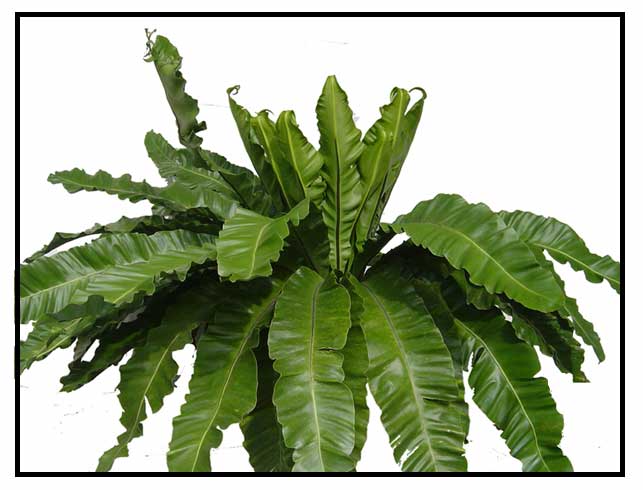Botany
Pakpak-lauin is a huge herbaceous epiphyte at minor or moderate altitudes.
Entangled rhizome is a mass of roots below.
Leaves are erect and flaring from the crown aggregated in a dense tuft above. Leaves are broad and numerous, radiating from the center of the plant
giving the appearance of a bird's nest; spiral, leathery,
smooth, lance-shaped with entire margins, sharply pointed tips and broad
bases. They often attain a large size, 40 to 120 centimeters long, 6 to 20 centimeters wide. Sori are numerous, elongate running along the line of the veinlets, reaching from the midrib about halfway to the margins.
Spores are bilateral, monolete with a perispore.

Distribution
- Common throughout the Philippines at low and medium altitudes.
- Cultivated as a hanging or landscaping plant.
-Grown extensively in other countries, usually as a ornament.
- Native of tropical countries; now grown extensively in America and Europe as an ornament.
 Constituents Constituents
- Fractionation and recognition of flavonoids by GC/MS yielded 12 known and 3 unknown compounds. Fractions 1 and 3 represented 13.12% and 2.61% of total composition (15.21%). Gliricidin7-O-hexoside was 3.83% followed by quercetin-7-O-rutinoside (3.09%), keampferol-3-O-rutinoside (0.19%), and myricetin-3-O-rhamnoside (1.10%). (see study below) (17)
Properties
- Considered spasmolytic, estrogenic, depurative, sedative.
- Studies have suggested estrogenic, antibacterial, antioxidant, anticancer properties.
Parts utilized
Leaves
 Uses Uses
Edibility
- Reported to be occasionally eaten by aboriginal tribe in Malaysia.
- In Taiwan, sprouts eaten as vegetable.
Folkloric
• The plant has
been reported to be depurative (purifying) and sedative.
• Plant has been used for halitosis.
• The Malay used a decoction of leaves to ease labor pains; also, lotion from pounded leaves in water used as poultice to the head to relieve fever. (12)
• In French Polynesia, used
for stings and bites, contraception, chest pains and lice.
• In Hawaii, shoots used for general weakness, ulcers, and sores. Also, plant is part of an asthma regimen,
mixed and pounded together with flowers of ki, mixed with poi made from kalo or uala (Ipomoea batatas).
• Shoots used for general debility, sores, ulcers.
• In Taiwan, used to treat fever; infusion used to alleviate labor pains, asthma, debility, halitosis, and sores. (8)
- In Malaysia, leaves used to treat fever and ease labor pains. (18)
• In North Eastern India, rootstock used against fever and elephantiasis. Also, used as emollient, in coughs and diseases of the chest. Leaf is smoked to treat colds. (9)
• In Kumaun Himalaya, Uttrakhand, India, used in splenic enlargement, urine calculus, jaundice, and malaria. (11)
• In India, plant used for fever and urinary problems. Leaf paste applied to affected body parts for body pain. (22)
• In Madya Pradesh, used for jaundice and malaria. (15)
• In Guam, leaf and root of the fern used as ingredient in medicinal preparations. (19)
• In Arunachal Pradesh, rootstock used for fever and elephantiasis. Used as emollient in coughs and diseases of the chest. Leaf is smoked to treat colds. (20)
• In Indonesia, minced leaves mixed with grated coconut used as hair shampoo. In Malaysia, cooling lotion made from leaves macerated in water applied to head for feverish conditions; similar preparation applied locally to ease labor pains. (21)
• In Vanuatu, used as contraceptive: the young fronds are eaten just following the menstrual period. (21)
Others
• Veterinary: In Papua New Guinea, leaves used as contraceptive in pigs. (12)
• Rituals: In Guam, used decoratively in wedding fiestas and religious rituals. (19)
Studies
• Estrogenic
Activity: Maternity and medicinal plants in Vanuatu II. Pharmacological
screening of five selected species: Five plant species, including A nidus, were studied for possible
estrogenic activity.
(1)
• Antibacterial
Activity: In a study of five medicinal ferns, including Asplenium nidus, all showed antibacterial activity which may justify its use in traditional medicine. (2)
• Patent Application for Prostatic Disease: Patent application has been made for the use of extract of Asplenium nidus with therapeutic effects on treatment and prophylaxis of prostatic diseases. The objective of the invention is an extract capable of modulating the secretion of androgen. The extract comprises pyropheophorbide a methyl ester, pheophorbide a methyl ester, 1-linleoyl-3-linolenoyl-glycerol, 1-linleoyl-2,3-dipalmitoyl-rac-glycerol and 1,3-dipalmitoyl- sn-glycerol. (10)
• Antiviral / Cytotoxicity Testing: Study evaluated six plant extracts of three local Malaysian medicinal plants—Asplenium nidus, Eleusine indica, and Phaleria macrocarpa— for cytotoxicity and antiviral activities. Cytotoxicity screening in Vero cell line by MTT assay showed safety of the extracts even at high concentrations. Antiviral properties by plaque reduction assay showed EC concentration between 3.2 to 47 mg/mL suggesting the usefulness of the extracts as potential antiviral agents. (13)
• Antibacterial / Frond: Study of extracts of fonds of A. nidus for antimicrobial activity against four potentially pathogenic microorganisms viz. E. coli (MTCC 1610), P. aeruginosa (MTCC 3541), S. aureus (MTCC 3160) and S. pyogenes (MTCC 1928) showed positive results. (16)
•
Anti-Cancer / Antibacterial / Antioxidant / Flavonoids: GC/MS fractionation of bioactive flavonoids yielded 12 known and three unknown compounds. Study reports on flavonoids that may act as therapeutically useful compounds against MDR pathogens. Most extracted flavonoids (gliricidin-7-O-hexoside (78.1%) and quercetin-7-O-rutinoside (69.2%) showed a significant in vitro radical scavenging activity by DPPH assay. Both fractions showed cytotoxic effects on human hepatoma HepG2 and human carcinoma HeLa cells. (see constituents above) (17) Availability
Wild-crafted.
Cultivated.
|




 Constituents
Constituents Uses
Uses

